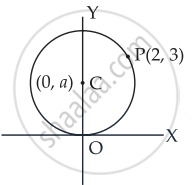Advertisements
Advertisements
Question
Equation of the circle with centre on the y-axis and passing through the origin and the point (2, 3) is ______.
Options
x2 + y2 + 13y = 0
3x2 + 3y2 + 13x + 3 = 0
6x2 + 6y2 – 13x = 0
x2 + y2 + 13x + 3 = 0
Solution
Equation of the circle with centre on the y-axis and passing through the origin and the point (2, 3) is x2 + y2 + 13y = 0.
Explanation:
Let the equation of the circle be (x – h)2 + (y – k)2 = r2
Let the centre be (0, a)
∴ Radius r = a
So, the equation of the circle is (x – 0)2 + (y – a)2 = a2
⇒ x2 + (y – a)2 = a2
⇒ x2 + y2 + a2 – 2ay = a2
⇒ x2 + y2 – 2ay = 0 ......(i)
Now CP = r
⇒ `sqrt((2 - 0)^2 + (3 - a)^2) = a`
⇒ `sqrt(4 + 9 + a^2 - 6a) = a`
⇒ `sqrt(13 + a^2 - 6a) = a`
⇒ `13 + a^2 - 6a = a^2`
⇒ `13 - 6a = 0`
∴ `a = 13/6`
Putting the value of a in equation (i) we get
`x^2 + y^2 - 2(13/6)y` = 0
⇒ 3x2 + 3y2 – 13y = 0
APPEARS IN
RELATED QUESTIONS
Find the equation of the circle whose centre is (1, 2) and which passes through the point (4, 6).
Find the equation of the circle whose centre lies on the positive direction of y - axis at a distance 6 from the origin and whose radius is 4.
If the equations of two diameters of a circle are 2x + y = 6 and 3x + 2y = 4 and the radius is 10, find the equation of the circle.
Find the equation of a circle which touches x-axis at a distance 5 from the origin and radius 6 units.
Find the equation of the circle which touches the axes and whose centre lies on x − 2y = 3.
A circle whose centre is the point of intersection of the lines 2x − 3y + 4 = 0 and 3x + 4y− 5 = 0 passes through the origin. Find its equation.
A circle of radius 4 units touches the coordinate axes in the first quadrant. Find the equations of its images with respect to the line mirrors x = 0 and y = 0.
Find the equations of the circles touching y-axis at (0, 3) and making an intercept of 8 units on the X-axis.
One diameter of the circle circumscribing the rectangle ABCD is 4y = x + 7. If the coordinates of A and B are (−3, 4) and (5, 4) respectively, find the equation of the circle.
Find the coordinates of the centre and radius of the following circle:
1/2 (x2 + y2) + x cos θ + y sin θ − 4 = 0
Find the equation of the circle passing through the points:
(5, −8), (−2, 9) and (2, 1)
Find the equation of the circle passing through the points:
(0, 0), (−2, 1) and (−3, 2)
Find the equation of the circle which passes through the points (3, 7), (5, 5) and has its centre on the line x − 4y = 1.
Find the equation of the circle concentric with the circle x2 + y2 − 6x + 12y + 15 = 0 and double of its area.
Find the equation to the circle which passes through the points (1, 1) (2, 2) and whose radius is 1. Show that there are two such circles.
Find the equation of the circle concentric with x2 + y2 − 4x − 6y − 3 = 0 and which touches the y-axis.
Find the equation of the circle passing through the origin and the points where the line 3x + 4y = 12 meets the axes of coordinates.
Find the equation of the circle whose diameter is the line segment joining (−4, 3) and (12, −1). Find also the intercept made by it on y-axis.
Find the equations of the circles which pass through the origin and cut off equal chords of \[\sqrt{2}\] units from the lines y = x and y = − x.
Write the coordinates of the centre of the circle passing through (0, 0), (4, 0) and (0, −6).
If 2x2 + λxy + 2y2 + (λ − 4) x + 6y − 5 = 0 is the equation of a circle, then its radius is
The equation x2 + y2 + 2x − 4y + 5 = 0 represents
The radius of the circle represented by the equation 3x2 + 3y2 + λxy + 9x + (λ − 6) y + 3 = 0 is
The number of integral values of λ for which the equation x2 + y2 + λx + (1 − λ) y + 5 = 0 is the equation of a circle whose radius cannot exceed 5, is
If the point (2, k) lies outside the circles x2 + y2 + x − 2y − 14 = 0 and x2 + y2 = 13 then k lies in the interval
If the circle x2 + y2 + 2ax + 8y + 16 = 0 touches x-axis, then the value of a is
The circle x2 + y2 + 2gx + 2fy + c = 0 does not intersect x-axis, if
